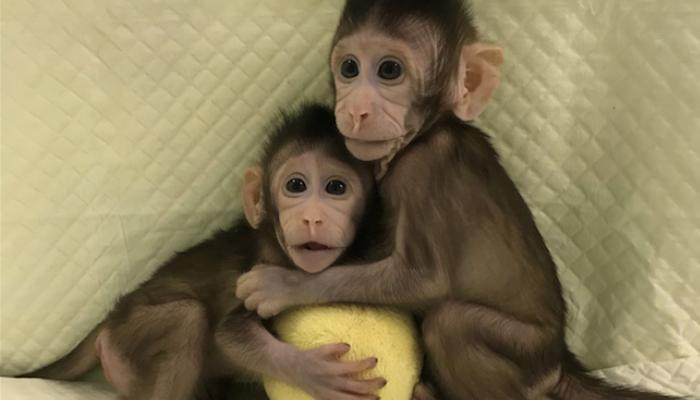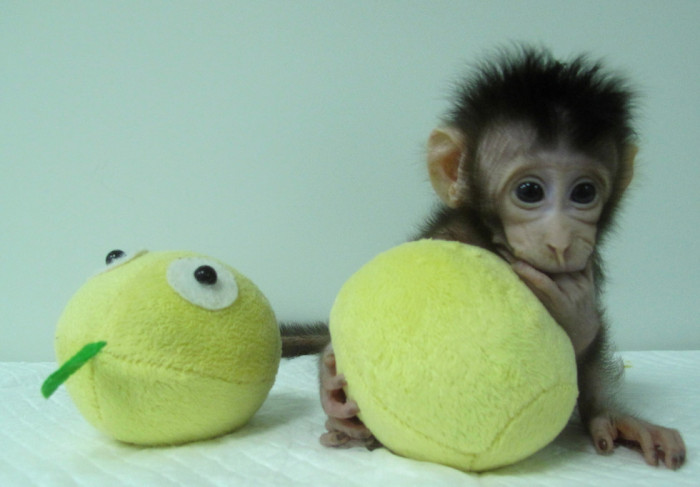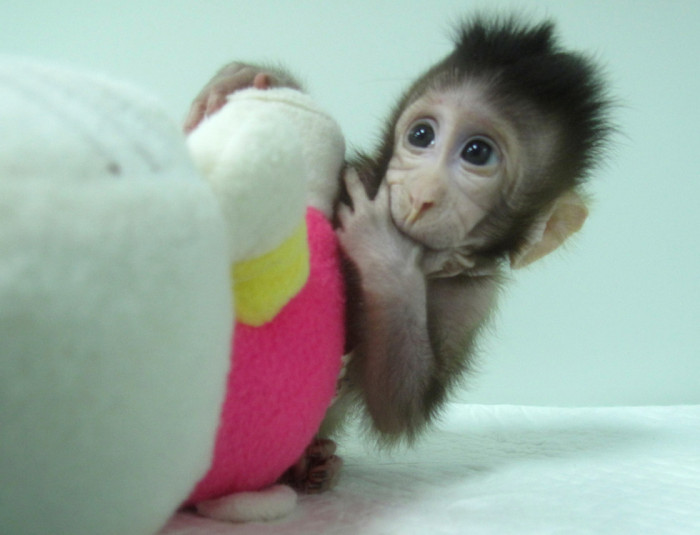Monkey Clones Created in the Lab. Now What?
 In a world first, Chinese researchers have successfully cloned macaques using the same technique that yielded the famous clone Dolly the sheep. The milestone, published in Cell on Wednesday, marks the first time that primates have ever been cloned in such a manner. The years-long effort, led by Chinese Academy of Sciences postdoctoral fellow Zhen Liu, culminated in the recent birth of two female macaques, Zhong Zhong and Hua Hua. The macaques’ names are drawn from the word zhonghua, an adjective for the Chinese people. The two macaques—eight weeks and six weeks old—are genetically identical, both clones of the same donor culture of fetal monkey cells. The young monkeys are reportedly healthy and currently live in an incubator. The discovery potentially leads to a brave new world of biomedical research and will unquestionably spark debate over cloning another primate species: humans. Here’s everything you need to know about these potentially controversial clones. ARE THESE THE FIRST CLONED MONKEYS? “It’s about time, because I thought it would never happen,” says Shoukhrat Mitalipov, the head of Oregon Health and Science University’s Center for Embryonic Cell and Gene Therapy. He wasn’t involved with the study, but he worked on previous monkey-cloning efforts. SO WHY IS THIS A BIG DEAL? Since then, scientists have cloned more than 20 species—from cows to rabbits to dogs—using this technique, but the Chinese effort marks the first time that non-human primates have been cloned successfully in the same way. This is a big deal, because the cloning technique in this study may apply to other primates such as humans. However, the study’s authors stress that they have no intention of cloning humans. HOW DOES THIS CLONING METHOD WORK? They then chemically prod the egg into developing, as if it had been naturally fertilized. If this embryo reaches a certain stage of development, scientists can then implant it into the surrogate. If the procedure is successful, the surrogate will get pregnant and give birth to an animal that is genetically identical to the nucleus donor. WHY DID IT TAKE SO LONG TO CLONE PRIMATES THIS WAY? To increase the odds of success, researchers must nudge the donor nucleus’s DNA into resembling the DNA of a young embryo. Turning back this genetic clock requires complex chemical protocols that must be fine-tuned for individual species. In part, this is why monkey cloning long proved elusive. The team in China tried several versions of the method before one worked, says study coauthor Qiang Sun, director of the Nonhuman Primate Research Facility at the Chinese Academy of Sciences Institute of Neuroscience. Sun’s team temporarily bathed the clone eggs in trichostatin A, a compound that helped ensure the donor DNA didn’t bunch up. They also prodded the eggs to make enzymes that snipped certain chemical tags off the donor DNA, freeing up locked embryonic genes. The researchers also tried creating clones from both adult and fetal cells, but only clones derived from fetal cells survived. It’s thought that the fetal cells were less “hardened” into their cell types than the adult cells, but because the fetal cells were differentiated, they too required reprogramming. WHY CLONE MONKEYS IN THE FIRST PLACE? “For the cloning of primate species, including humans, the technical barrier is now broken,” says study coauthor Mu-Ming Poo, who directs the Center for Excellence in Brain Science and Intelligence Technology at the Chinese Academy of Sciences. “However, the reason we chose to break this barrier is to produce animal models that are useful for human medicine. There’s no intention to apply this method to humans.” Koen Van Rompay, a virologist at the California National Primate Research Center, thinks that such clones would be useful in the long run: “If there would be an efficient way to clone monkeys, that could actually reduce the number of monkeys needed to answer a certain research question,” he says. Van Rompay and Mitalipov caution, however, that the promised therapeutic benefits may not be right around the corner. For one, the technique doesn’t strike them as particularly efficient. Of the team’s 21 cloning attempts using fetal donor cells, only two resulted in healthy live births. What’s more, Zhong Zhong and Hua Hua are only two months old. Researchers don’t yet know what infirmities, if any, will afflict them later in life as a result of being cloned. “This is just a step,” says Van Rompay. “We are not ready to clone monkeys large-scale.” BUT IS IT ETHICAL TO MAKE CLONES? China, in particular, faces high scrutiny on matters of animal welfare because it has no comprehensive laws against animal cruelty. The study authors say that their facilities follow animal-welfare regulations set by the U.S. National Institutes of Health and that they are attentive to the macaques’ welfare. It’s possible that improvements in genetics and computer modeling will limit the need for lab monkeys, says Eliza Bliss-Moreau, a behavioral neuroscientist at the California National Primate Research Center. “Technology has advanced so much in the last decade,” she says. “Some of the questions that you would think of in behavioral neuroscience as being targets for [cloning], we’re already tackling in other ways.” But many biomedical researchers insist that primate models are still necessary for studying complex human diseases and disorders, from Parkinson’s to HIV/AIDS to autism. “I don’t think there will ever be a way we can avoid non-human primates in biomedical research,” says Van Rompay. “If that happens, that would be great, but right now, in-vitro and computer models are not sufficient.” Johns Hopkins University bioethicist Jeffrey Kahn, an expert on the use of primates in biomedical research, says that the questions this new study poses are complex: “Should we invest in this or organs on a chip? I don’t think it’s that simple.” WHAT DOES THIS MEAN FOR CLONING HUMANS? Whether reproductive human cloning should proceed, however, is another question entirely. All of the scientists interviewed by National Geographic stressed that at present, human cloning would be unnecessary and irresponsible. “There’s no reason to clone humans at this time,” says Poo. “There must be international discussion on this issue.” Bioethicist Kahn urges a global discussion, as well: “What should we do about it—the ‘we’ being societies, countries, oversight bodies, governments?” he says. “What kind of governance do we think is necessary to prevent bad things from happening to humans, in the context of technology like this?” WHAT’S NEXT? “With all this improvement, along with the high standards of ethical concerns, I think that Chinese society will accept this,” says Poo. “I hope that societies in Western countries will realize once we demonstrate the cloned monkeys’ usefulness in curing disease, they will gradually change their mind.”   |

Japan Unveils Human Washing Machine, Now You Can Get Washed Like Laundry (video)
123501.12.2025, 20:45
Chinese humanoid robot sets Guinness World Record with 106-km inter-city walk (video)
85924.11.2025, 16:30
Musk։ Optimus will be able to eliminate poverty and provide everyone with a universal high income (video)
84523.11.2025, 12:45
AGMI researchers expose the hidden role of female perpetrators in the Armenian Genocide (photo)
82613.11.2025, 21:15
LVM3-M5 mission successfully launches CMS-03 satellite (video)
113402.11.2025, 21:17
Google разработала квантовый алгоритм, работающий в 13 тыс. раз быстрее алгоритма суперкомпьютеров
148522.10.2025, 23:44
